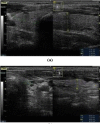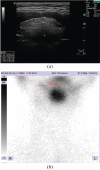Ultrasound Imaging of Cervical Anatomic Variants
- PMID: 33504311
- PMCID: PMC8653420
- DOI: 10.2174/1573405617666210127162328
Ultrasound Imaging of Cervical Anatomic Variants
Abstract
Embryologic developmental variants of the thyroid and parathyroid glands may cause cervical anomalies that are detectable in ultrasound examinations of the neck. For some of these developmental variants, molecular genetic factors have been identified. Ultrasound, as the first-line imaging procedure, has proven useful in detecting clinically relevant anatomic variants. The aim of this article was to systematically summarize the ultrasound characteristics of developmental variants of the thyroid and parathyroid glands as well as ectopic thymus and neck cysts. Quantitative measures were developed based on our findings and the respective literature. Developmental anomalies frequently manifest as cysts that can be detected by cervical ultrasound examinations. Median neck cysts are the most common congenital cervical cystic lesions, with a reported prevalence of 7% in the general population. Besides cystic malformations, developmental anomalies may appear as ectopic or dystopic tissue. Ectopic thyroid tissue is observed in the midline of the neck in most patients and has a prevalence of 1/100,000 to 1/300,000. Lingual thyroid accounts for 90% of cases of ectopic thyroid tissue. Zuckerkandl tubercles (ZTs) have been detected in 55% of all thyroid lobes. Prominent ZTs are frequently observed in thyroid lobes affected by autoimmune thyroiditis compared with normal lobes or nodular lobes (P = 0.006). The correct interpretation of the ultrasound characteristics of these variants is essential to establish the clinical diagnosis. In the preoperative assessment, the identification of these cervical anomalies via ultrasound examination is indispensable.
Keywords: Cervical anomalies; cervical cysts; cervical ultrasound; parathyroid gland anomalies; thyroid anomalies; zuckerkandl tubercles (ZTs)..
Copyright© Bentham Science Publishers; For any queries, please email at epub@benthamscience.net.
Figures





Similar articles
-
Role of cervical ultrasound in detecting thyroid pathology in primary hyperparathyroidism.J Surg Res. 2014 Aug;190(2):575-8. doi: 10.1016/j.jss.2014.03.038. Epub 2014 Mar 19. J Surg Res. 2014. PMID: 24739507
-
Ultrasonography does not consistently detect parathyroid glands in healthy cats.Vet Radiol Ultrasound. 2018 Nov;59(6):737-743. doi: 10.1111/vru.12661. Epub 2018 Jul 11. Vet Radiol Ultrasound. 2018. PMID: 29998595
-
99mTc-MIBI radio-guided minimally invasive parathyroidectomy: experience with patients with normal thyroids and nodular goiters.Thyroid. 2002 Jan;12(1):53-61. doi: 10.1089/105072502753451977. Thyroid. 2002. PMID: 11838731
-
The thyroid and parathyroid glands. CT and MR imaging and correlation with pathology and clinical findings.Radiol Clin North Am. 2000 Sep;38(5):1105-29. doi: 10.1016/s0033-8389(05)70224-4. Radiol Clin North Am. 2000. PMID: 11054972 Review.
-
Ultrasound in head and neck surgery: thyroid, parathyroid, and cervical lymph nodes.Surg Clin North Am. 2004 Aug;84(4):973-1000, v. doi: 10.1016/j.suc.2004.04.007. Surg Clin North Am. 2004. PMID: 15261750 Review.
References
-
- Muktyaz H., Birendra Y., Dhiraj S., et al. Anatomical variations of thyroid gland and its clinical significance in North Indian population. Global J Biol Agric Health Sci. 2013;2:12–16.
-
- Suzuki S., Midorikawa S., Fukushima T., Shimura H., Ohira T., Ohtsuru A., Abe M., Shibata Y., Yamashita S., Suzuki S. Thyroid examination unit of the radiation medical science center for the fukushima health management survey. Systematic determination of thyroid volume by ultrasound examination from infancy to adolescence in Japan: the Fukushima Health Management Survey. Endocr. J. 2015;62(3):261–268. doi: 10.1507/endocrj.EJ14-0478. - DOI - PubMed
MeSH terms
LinkOut - more resources
Full Text Sources
Other Literature Sources
Medical

